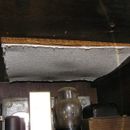Old radios and asbestos
Last week my wife Jessica brought home a neat old radio and turntable in a cabinet.
Her idea is to turn this old cabinet radio into a vanity.
During my inspection of the cabinet I noticed what appears to be an asbestos “heat shield” stapled to the cabinet above some vacuum tubes.
The asbestos does not appear damaged.
There are no plans to repair the radio into working condition so I would like to remove the asbestos if we will be using the cabinet in our house.
When I contacted a local asbestos removal business about what I might do, the guy I spoke with told me to soak it down with water, take it out, wrap it up and throw it out…
This advice seems consistent with some advice I had read on some “old radio” forums…
Anybody here have any insights?
GBA Detail Library
A collection of one thousand construction details organized by climate and house part










Replies
Lucas,
While the advice you received makes sense, there are a lot of things that can go wrong. I imagine that most GBA readers are reluctant to give advice that promotes do-it-yourself asbestos abatement.
In other words, when in doubt -- let the experts do it.
That said, the advice is somewhat logical. The great danger with asbestos is that some so-called friable fibers -- the kind of fibers that aren't bound up in a solid product, but look flaky and loose -- can become airborne. That's bad. You don't want any of the asbestos to be disturbed while the cabinet is indoors.
A secondary concern: will a small amount of asbestos be clinging to the cabinet after you yank out that piece? If so, will the fibers become friable and airborne in the future?
When in doubt, be cautious.
Martin,
Thanks for the response.
I know this is probably tricky territory in terms of liability.
I'll have to give it some more thought...
We plan on recycling a lot of old things into useful things for our house so this is a good learning experience.
I find it funny to think that for many years people had appliances like these in their homes and didn't give a single thought to whether the materials contained within them posed a health risk - why would they?
Just an interesting illustration of how what you don't know can still hurt you.
Don't forget the lead batteries in radios like the old portable Airline ones, too. What a mess. I've had to dispose of that....
Slightly off topic, but anyway, since you're talking about recycling old things: as long as you're setting up that pretty cabinet, despite the fact that the amplifier is probably only so-so and would be a pain to rehab, bear in mind that the speakers in there might be halfway decent, and consider putting them to use after all by hooking in a $20 Class T amplifier instead, which barely sips any power and is perfectly sufficient if, say, you're only going to play mp3s anyway. Make that pretty case work for you.
Here's a Class T amp which you could set right inside:
http://www.amazon.com/LP-2020A-Lepai-Tripath-Class-T-Amplifier/dp/B0049P6OTI/ref=pd_sim_e_1
Minneapolis,
Thanks for the idea.
The existing amp is going to have to be pulled out to make way for plumbing, but I like your idea of putting back in a small amp for some MP3 ambiance.